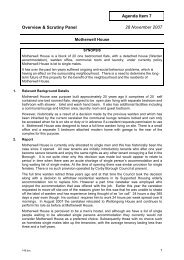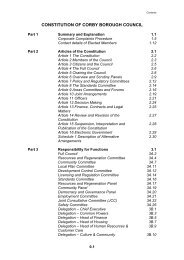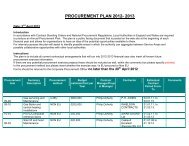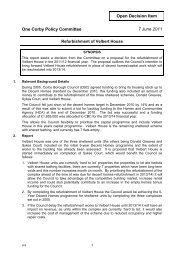North Northamptonshire Annual Monitoring Report 2010-11
North Northamptonshire Annual Monitoring Report 2010-11
North Northamptonshire Annual Monitoring Report 2010-11
Create successful ePaper yourself
Turn your PDF publications into a flip-book with our unique Google optimized e-Paper software.
61<br />
The review of the NNCSS will provide an opportunity to review the phasing of housing delivery in the light of<br />
prevailing market conditions and low rates of delivery achieved early in the plan period (relative to targets). This is<br />
due to the impact of the economic recession on the housing market and on infrastructure provision, not because<br />
of a shortage of sites for house building – there are currently over 24,000 house plots in <strong>North</strong> <strong>North</strong>amptonshire<br />
with planning permission or resolutions to grant permission. The NNJPU will support the planning authorities in<br />
ensuring that housing developments accord with the NNCSS, including its overall spatial strategy, design quality<br />
and infrastructure requirements. In the meantime, an update of the Strategic Housing Market Assessment will<br />
inform revised NNCSS housing targets and may in the short term enable an interim policy approach to be adopted<br />
by the local planning authorities<br />
The Executive Summary at the beginning of the AMR provides a summary of performance against key indicators.<br />
The picture is mixed and the positives, unclear results and negatives are addressed below, within the framework<br />
set out by the following key questions:<br />
• Overall Spatial Strategy – where is development happening?<br />
• Economy and town centres – is a jobs/homes balance being achieved?<br />
• Housing – are targets being met?<br />
• Environmental quality – is it improving?<br />
• Infrastructure - is investment matching growth?<br />
WHERE IS DEVELOPMENT HAPPENING?<br />
The focus of new development is still very much within the ‘urban core’, with 49% of residential development<br />
taking place at the three Growth Towns and 30% at the smaller towns (including Rushden). This compares to CSS<br />
targets of 66% and 17% respectively; highlighting the issue with deliverability of the major sites in the Growth<br />
Towns and the continued attractiveness of smaller sites in the other towns. Equally, rural development has again<br />
been greater than the CSS target (19% delivered against an <strong>11</strong>% indicative requirement), although this does<br />
include the large site at Little Stanion and some development at Mawsley.<br />
Housing completions on previously developed land made up 45% of all residential development, compared to a<br />
CSS target of at least 30%. Employment floor space on previously developed land made up 62% of all employment<br />
land development, though there is no specific CSS target set.<br />
IS THE JOB/HOMES BALANCE BEING ACHIEVED?<br />
Data is not specifically available for the <strong>2010</strong>-20<strong>11</strong> monitoring year, so instead long term trends have been<br />
examined and the impact of the recession highlighted by figures now available for 2008-<strong>2010</strong>. This shows that<br />
<strong>North</strong> <strong>North</strong>amptonshire as a whole is underperforming and that the recession has exacerbated this, with all<br />
districts losing jobs overall in the 2008-<strong>2010</strong> period.<br />
Strategic Planning for the Districts and Boroughs of Corby, Kettering, Wellingborough & East <strong>North</strong>amptonshire
















